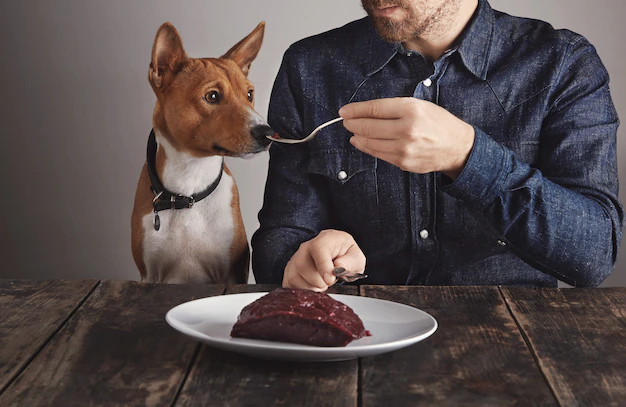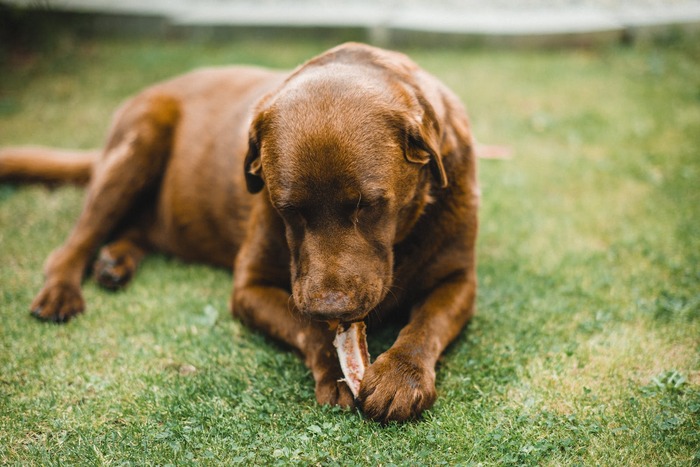2022-12-13
Feeding our beloved paw family members raw food has become a popular tendency among dog parents recently. Getting a shinier coat, cleaner teeth, having their general well-being improved, and last but not least-getting closer to their wild ancestors and the food they eat in nature…these are among the arguments that advocates of this tendency give to support their choice.
If you have been considering switching to a raw diet for your dog, you may want to read this article. We will let you know if a raw food diet actually has benefits for the health of paw friends or if it may be accompanied by any risks.
Let’s clarify first what “raw food diet” means.

As the name implies, this diet is based on raw foods, including meat, fruits, and vegetables. More specifically- it can feature fresh fruits and vegetables (non-toxic for dogs), muscle and organ meat, eggs (raw), and bones. Some people also include dairy products like plain yogurt in this type of diet. However, you should keep in mind, that many dogs are lactose intolerant. As a general rule, dairy products (mainly yogurt and cheese) should not be given as part of a dog’s regular diet, but rather as treats.
There are two popular raw food diet techniques:
1. The first one is based on what dogs’ ancestors would have eaten in nature, and it tries to mimic this type of food. It includes muscle meat (about 80%), bones (about 10%), and organ meat (about 10%).
2. The second type, also known as “Biologically Appropriate Raw Food” includes up to 60-80% raw meaty bones, i.e. wings, legs, tails, rib bones...etc., and up to 20-40% meat, vegetables, fruits, and eggs. Supplements can also be added.
You should keep in mind that just like with humans, there is no unified approach that works for all dogs. i.e. your paw friend may be allergic to certain diet ingredients. It is always recommended that you consult a veterinarian first, so they give you professional guidelines on what type of food, and in what proportion should be included in your dog’s raw diet. Also, every transition should take place gradually.
Raw meaty bones are included in the diet, as they supply dogs with phosphorus and calcium, while muscle meat is responsible for delivering protein. Organ meat such as kidney, heart, and liver are recommended because of the minerals and vitamins they provide. You should remember to implement veggies, fruits, legumes, and grains (not too many) in your dog’s diet. Be careful and make sure that all ingredients are safe for dogs.
Some important things you should know are that grains (i.e. cornmeal, rolled oats, millet), corn, and potatoes should be cooked. Otherwise, they can cause digestive issues in your dog if you have not prepared them prior to that.
For those of you who have a blender/mixer/juicer at home, it can be of great help, if you need to make certain ingredients easier for your dog to digest. Also, adding water to certain ingredients, such as chia seeds, will make them softer. You can mix a cup of water with a tablespoon (¾) of chia seeds and let the substance stay for a few minutes. Then you can whisk them. You should wait for 10-12 more minutes and whisk them again, prior to feeding your dog the seeds.
In case you are new in this area, and you are still quite unfamiliar with its specifics, you may want to rely on a prepared diet and not experiment yourself. It is essential that you look for a balanced diet, that provides your dog with all the nutrients he/she needs to properly develop. You should ensure that the products you intend to use, are organic, and do not include added hormones and antibiotics.
A general rule is, that the amount of raw food your dog eats in a week should not exceed 15% of his/her weight.
You should make sure that the ingredients you will incorporate in your paw friend’s diet are of high quality, regardless of whether you bought these from a store/farmers market or made them at home. Also, they should be in the right proportion, so your dog gets all the nutrients he/she needs. Otherwise, your paw friend may develop diseases, due to nutrient deficiency.

Bones that can be very beneficial for your dog, due to the phosphorus and calcium, they provide to your dog, can also cause serious issues.
People who have been actively keeping their dogs on a raw diet do not recommend bones to be cooked, as they get more fragile and may cause your dog to choke. However, raw bones can also cause issues such as constipation or esophageal blockage. If you want to make sure that bones, won’t cause digestive issues, you can grind them.
Just like humans, dogs can also get infected when they eat uncooked meat. Raw meat can be contaminated with different types of bacteria, including Salmonella. If you think that raw meat is safe, since wild ancestors of dogs-wolves, eat carcasses, this is not completely the case. There is a chance for commercially processed products to have gotten contaminated during the preparation. This is especially valid for products such as sausages, where meat has been mixed and ground. These processes make it easier for bacteria to get deep into the meat.
If your dog has gotten infected, you may notice diarrhea as a symptom. You will need to run tests, which are usually very expensive, to check whether these bacteria have caused the infection or not. Unfortunately, it is very likely that the real cause of diarrhea remains unknown and treatment only for the symptoms to be prescribed.
If your dog has been infected with Salmonella, he/she is likely to have diarrhea, which includes mucus and blood, and also to feel fatigued. Vomiting and fever are other possible symptoms.
Too young, too old dogs, pregnant dogs, dogs who live in a stressful environment, as well as dogs who have an underlying health condition are more likely to get Salmonella than healthy adult dogs.
Raw pork and raw fish meat from the Northwest Pacific are considered high-risk.

Yes, there is also a risk for humans. Just like our paw friends, our health is exposed to a risk, which is higher for babies, seniors, pregnant women, as well as people with a weakened immune system (especially if they undergo medical treatment). Contamination can happen through contact with infected food (i.e. during preparation) or through dog feces.
It is important to note that even if there are no symptoms in your dog, that imply the presence of an illness, bacteria still can be in his/her feces. Hence, you can get infected.
Some tips you may want to follow are:
-Cover and refrigerate food that has not been eaten and remove leftovers;
-Use separate food bows for your dog’s raw food;
-Keep raw food away from other food;
-Wash your hands thoroughly after you have prepared your dog’s raw meal;
-Wash your hands thoroughly after you have petted your canine or been licked by him/her;
-Do not kiss your dog on the face.